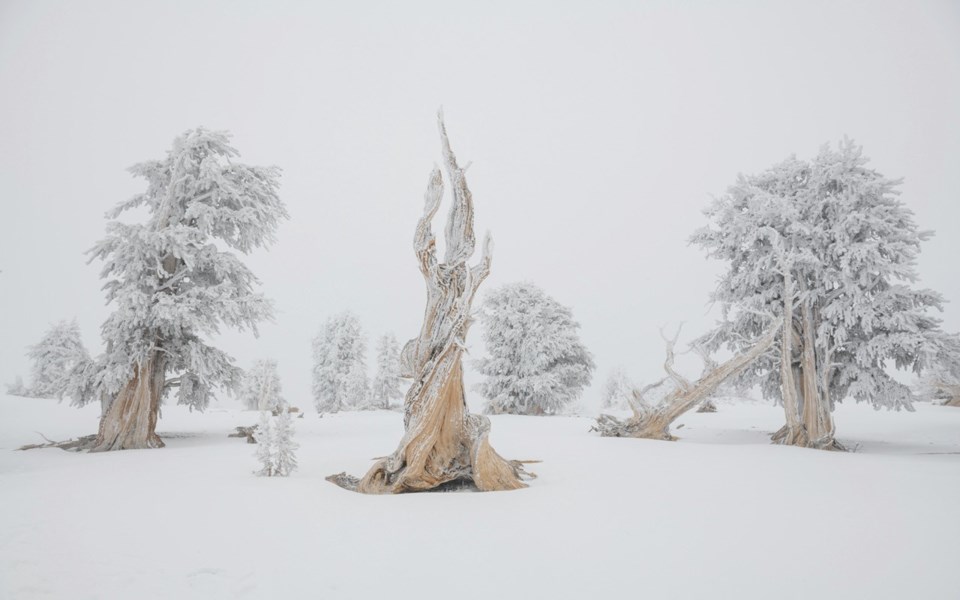This morning, on my way home from the school bus-stop, I detoured via a small patch of Douglas fir—the grandfather tree, called Srap7ul, in Ucwalmictws, the language of the Lil'wat Nation, meaning "something standing upright." I found a group of trees that seemed to form a rough circle, and inserted myself in the arc and stood there for a few minutes, thinking about the things they were giving that I wanted to express appreciation for, to acknowledge.
I attribute this new peculiar behaviour in large part to Jordan Manley. I don't think it's quite what he had in mind when he set out to make a film about tree-skiing for Patagonia in Dec. 2017. Then again, he did want to provoke action.
"Yes," admits Manley, "I did have an activist agenda. Absolutely."
It's an unexpected confession because the film feels like more of a hymn than a tirade, its 40 minutes of detailed photography, rich soundscapes, mostly serene activity, and unexpected revelations about trees (their persistence! their spirit! their interconnectedness! their consciousness!) left my alpha waves in a blissed out meditative state.
Manley has heard that a lot since Treeline: A Story Written in Rings premiered at the Banff Festival in October, and even more so, since it was released online, three weeks ago, where it's tracking upwards of 750,000 views.
The film began, originally, as a seed for a ski magazine feature. When he was working predominantly as an editorial photographer, Manley shared the idea of shooting a story about different tree-skiing locations around the world with fellow tree-skiing enthusiast, Leah Evans. "It floated out of my mind, but Leah held on to it." When Evans was brought under the shelter of Patagonia as one of its sponsored athletes, she pitched the idea, attached Manley's name to it, and out of the blue, seven years later, Manley was approached to make a film.
In the intervening years Manley had been travelling the world, making award-winning short films—the 12-part Skier's Journey series and The Curve of Time. He'd also suffered a concussion, and as part of his healing process, he spent two years wandering around the North Shore, seeking out the immense trees that had escaped being log, that the late Randy Stoltmann had honoured in his 30-year-old Hiking Guide to the Big Trees of Southwestern British Columbia. "That was a thrill."
Manley has always stood out creatively in our adrenalized niche. There's nothing frivolous in his work, and Treeline is equally invested with intention and care. Perhaps it's an adjunct to being forced to stop, heal and closely examine his life and identity, but the 34-year-old has a new level of resolve: "At this point, I feel like spending the limited time I have on earth trying to make a positive impact where I can, through the things that I know how to create and control."
And so, tasked with a mission—to entertain, to create something that would hold a viewer in an altered state, transport them into other people's lives, discover something new—he set out to make a film that would sing the being of trees back into our sightlines. "I thought quite a bit about how trees serve such foundational roles in our daily lives—every fresh breath of air we take, our buildings, our fuel, all of these things owed to trees that are kind of background to us on a daily basis. So in some ways this film was an effort to take trees out of the background and put them more in front of us."
Much of what we are now coming to understand about the forest, thanks to the research of scientists like UBC ecologist Dr Suzanne Simard, reconfigures our appreciation for its rich complexity. While we've been distracted looking at the treetops, skiing through the spaces between the trees, or assessing the trunks for board feet, much of a forest's majesty has been invisibly working beneath the ground—a network of fungi and roots and signals and energy transfers.
"From the beginning," says Manley, "I wanted the forests to feel alive, and part of that meant finding characters who feel really alive when they're in the forest and who feel that they are in communication with those places."
Through interviews with author Michael Cohen, paleoecologist Connie Millar, tree doctor Konami Tsukamoto, Shinto priest Akihiko Tamaki, and professor Suzanne Simard, conducted over five months of travelling to Japan, California, Nevada, and the B.C. interior, and shooting with a dozen athletes, Manley came away with all the different perspectives that would feed into the film, and leave him with an even deeper personal appreciation for trees.
In the same way that he, as a fly-fisherman, has come to appreciate the salmon, trying to be aware of the gift, he's conscious of a deeper upwelling of appreciation when he works with wood. "Every time I kill a fish, I tend to say thank you. Not that I think the fish needs to hear that or cares. It's dead. But if we're thanking an animal or a 'resource,' we're appreciating it and hopefully, we'll take better care of it, of all these things that are limited."
Is it going to be enough? Manley wonders. As I followed an upwelling instinct to go and stand in circle with the trees in my yard, and say thanks, I breathe in what you breathe out, you breathe in what I breathe out, it occurred to me, this is where changing the world begins. Past the initial burn of outrage. Stepping into loving communion.
The Velocity Project: how to slow the f*&k down and still achieve optimum productivity and life happiness.




